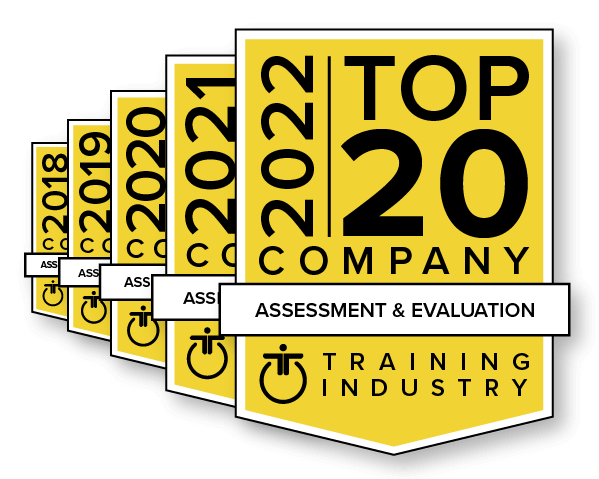As a business leader, you’ve probably heard the statistic that 70% of change efforts fail to achieve their goals. Failed change efforts lead to lower employee engagement and higher conflict.
Some percentage of change efforts probably should fail, because change is as much about learning as it is about performing. If you always succeed, you’re probably not experimenting enough.
And some change happens without being initiated, like the changes brought to businesses by the COVID-19 pandemic, and you have to respond.
So that leaves us with the question: What percentage of change efforts should fail? It’s impossible to give an exact target, but at Core Strengths, we believe that motivation-based change management is the way to bring that number down from 70%.
By learning about people’s primary motivations and considering those during your change effort, you can prepare your entire organization for successful change, whether it’s planned in advance or hits you out of nowhere.

Table of contents
The three primary motivations.
According to Core Strengths research, people are driven by three primary motivations:
- Concern for People (Blue)
- Concern for Performance (Red)
- Concern for Process (Green)

When you take the SDI 2.0 assessment, you’ll get a full portrait of how all three blend in your personality, but even if you haven’t taken the assessment yet, keep reading.
The SDI 2.0 describes a vast array of diverse personalities, just like the colors blue, red, and green can create any color on your computer monitor. But we’re going to keep it simple, by focusing on the three colors.
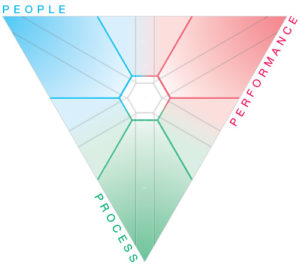
People/Blue: People who are motivated by the protection, growth, and welfare of others. They have a strong desire to help others who can genuinely benefit.
Performance/Red: People who are motivated by task accomplishment and achieving results. They have a strong desire to set goals, take decisive action, and claim earned rewards.
Process/Green: People who are motivated by meaningful order and thinking things through. They have a strong desire to pursue independent interests, to be practical, and to be fair.
As you can imagine, people with different primary motivations have very different responses to your change efforts.
If motivation-based relationships are part of your company culture, creating change communications that speak to people with all three motivations becomes much easier.
Why do so many change efforts fail?
There are many reasons change efforts fail, but here are three that we see often in our work with clients.
1. People think change will end.
Leaders and employees tend to think change has a beginning, a middle, and an end. But business is based on continuous iterations, so people in business should expect continuous change.
When people can learn to enjoy the journey, change feels more experimental—and even fun. But people still need progress markers. During change efforts, make sure to call attention to milestones along the way that speak to each of the three motivations.
2. People are surprised by their sense of exclusion.
Change creates in-groups and out-groups. Someone who felt valued by the organization can suddenly feel just the opposite when they find out a change was underway and they weren’t in the conversation.
It’s impossible to completely eliminate this phenomenon, but you can reframe it by making sure people with all three primary motivations feel included throughout the change effort.
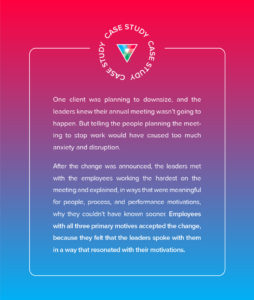
3. Leaders don’t foster a personal sense of ownership.
The people leading the change often over-focus on what motivates them to change, and under-focus on what motivates their constituents.
Usually, change communications focus on process and performance, so individuals with those primary motivations feel more heard during the change. Leaders should take extra care to put energy and attention into engaging individuals with strong people motivations.
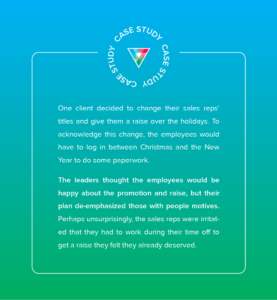
Keys to successful change management.
Each time a change arises, leaders need to understand their goal, then figure out how not to exclude anyone.
The key for a change leader is to make sure all their communications speak to people with each of the three primary motivations. When your leadership team asks each of the following questions, you’ll get a sense of your potential motivation-based blind spots, so you can fix them in future communications.
The 12 questions to ask during every change effort.
Overarching question:
Does this initiative align with our purpose and practical values?
Developing a motivating and empowering environment
- What metrics will be used to help us assess our progress?
- What feedback loops will help us assess the impact of this initiative?
- How will we celebrate progress and goal attainment?
Partnering (people motives)
- Who is impacted by this initiative?
- Have they been given a chance to share their perspective?
- How will we ensure these voices are heard?
Visioning with systems thinking (process motives)
- What are the underlying assumptions informing this initiative?
- What are possible unintended consequences of this initiative?
- Do we have the processes, systems, and resources (money, people, time) to execute this initiative?
Foresight and visioning (performance motives)
- What is the purpose of the initiative?
- What is the goal of the initiative and does it support the strategic objectives of the organization?
- Specifically, what will be different in the future than it is today?
Leaders want to avoid announcing a change and then realizing that people are affected in ways they hadn’t considered. But as long as the process of coming to the change considers all three primary motives, you should be in the clear.
Even if you have to deliver bad news, constituents will forgive you if they feel heard and understood. And that’s the definition of a change effort that succeeds.
Core Strengths has the tools and expertise to help your organization navigate change successfully.

Successful change management isn't a one-size-fits-all approach.
Download our ’12 Questions to Ask During Every Change Effort’ form



